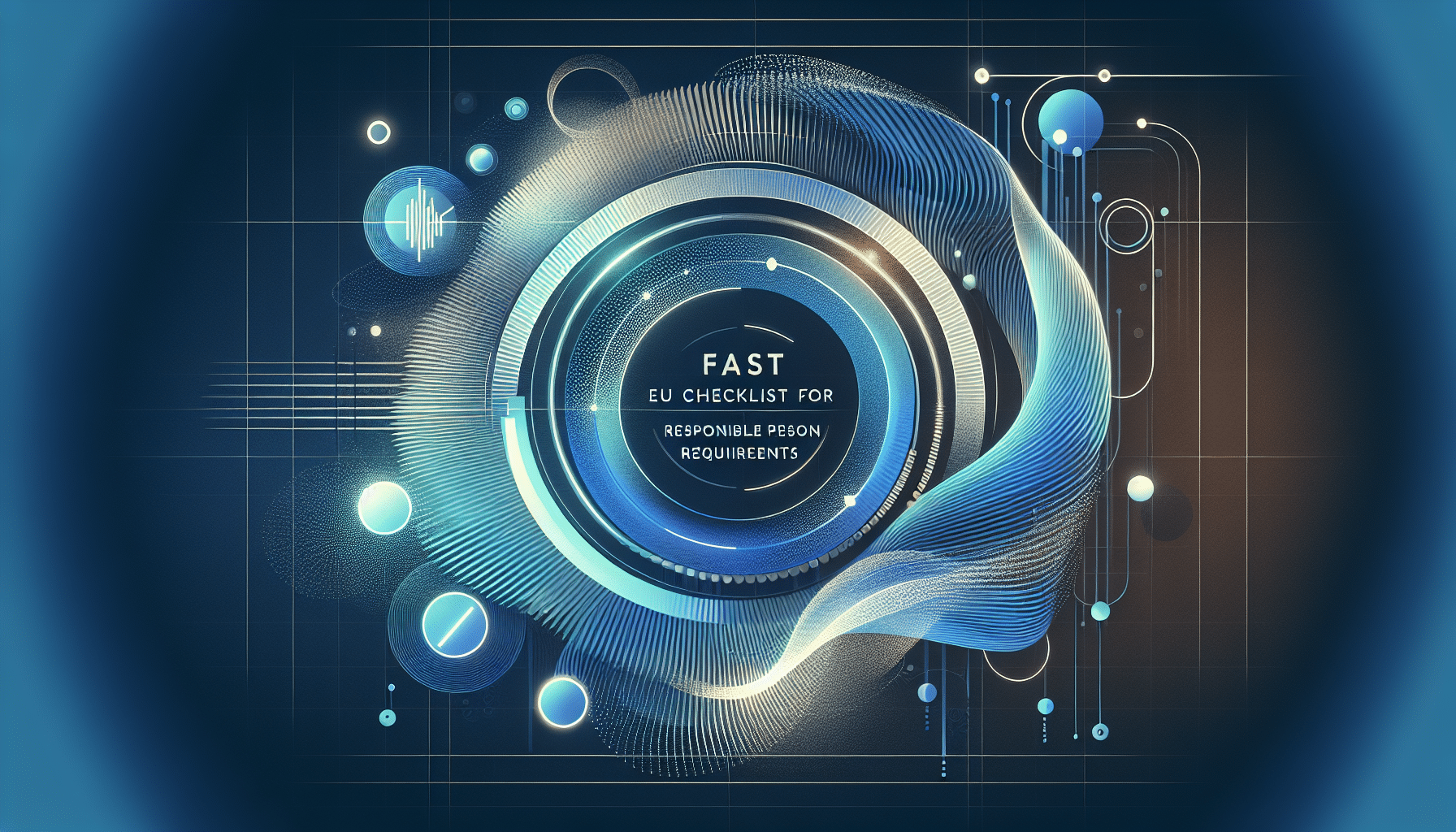About eldris
epr.eldris.ai leads the EPR sector, in fast, automated, AI Agent EU Complaince. LUCID Packaging, WEEE, and Battery Compliance for Brands, E-Commerce and Service based businesses expanding into the EU.
In This Article
- Appoint an EU-based Responsible Person early in your market entry planning.
- Maintain fully prepared and updated technical documentation at all times.
- Leverage compliance tools and expert support to enhance efficiency.
- Conduct regular audits and maintain transparent communication with your RP.
- Stay alert to regulatory changes impacting the scope of the RP’s authority.
What Is an EU Responsible Person?
Understanding Key Definitions and Legal Background
The term “Responsible Person Requirements” encompasses a set of legal obligations defined under EU regulations, primarily for manufacturers or importers placing products on the European market. A Responsible Person (RP) is an individual or organisation based within the European Union who is designated to act on behalf of a non-EU manufacturer in ensuring product compliance. The RP plays a critical role in product safety and market approval, particularly for CE-marked goods, cosmetics, medical devices, and general consumer products.
Regulatory frameworks such as the General Product Safety Regulation (GPSR), the Medical Devices Regulation (MDR), and the EU Cosmetic Products Regulation (EC) No 1223/2009 also stipulate the need for a Responsible Person to fulfil specific compliance activities. These include holding technical documentation, cooperating with supervisory authorities, and acting as a point of contact in the event of safety investigations or product recalls.

Why Appointing One Is Mandatory
GPSR and CE Marking Requirements Explained
EU legislation demands that only compliant products can circulate within the European Economic Area (EEA). For entities outside the EU, such as manufacturers based in the United States, China, or the UK post-Brexit, appointing an EU-based Responsible Person is a non-negotiable prerequisite. This requirement forms part of the legal strategy to ensure traceability, consumer safety, and market readiness.
The General Product Safety Regulation explicitly mandates that every product must have a contact person located in the EU capable of providing the relevant safety information to the competent authorities. Likewise, CE marking directives for electronics, machinery, toys, and personal protective equipment often include an RP clause. This person must be clearly identifiable on the product packaging, labelling, or accompanying documentation.
“A clearly defined Responsible Person is the linchpin of product compliance across EU markets.”
Essential Documents You Need Ready
One of the most immediate responsibilities of the Responsible Person is access to and availability of technical documentation. According to the legal framework, this documentation must be maintained in electronic or physical form and be made available to authorities upon request for at least 10 years after the product has been placed on the market.
The primary set of documents typically includes the Declaration of Conformity (DoC), user manuals in the appropriate languages, risk assessments, and conformity assessment procedures. For cosmetic products, the Product Information File (PIF) is mandatory and must include the safety report, labelling, proof of claimed effects, and the manufacturing method.
Failure to collect or organise these files could severely delay your market entry or, worse, prompt a product withdrawal from EU stores. Without these properly formatted and up-to-date documents, the Responsible Person cannot fulfil their role effectively — a legal liability no manufacturer can afford.
Technical Files: Your Submission Blueprint
Technical files act as the comprehensive evidence pack proving that your product complies with all applicable legislative requirements. These files underpin the CE marking and are critically assessed during market surveillance procedures. An RP must have immediate access to these upon a request from an EU authority.
So, what should your technical file include? At minimum, it needs design and manufacturing details, product specifications, quality control and test reports, alongside a thorough risk management file. It must also contain third-party certifications, copies of EU-type examination certificates when applicable, and clear labelling history.
You’ll also need to tailor the file according to your product category. A toy manufacturer, for example, must document small part testing and toxicity profiles, while an electronics producer may be asked to provide electromagnetic compatibility (EMC) test results and circuit diagrams.
Timeline for EU Approval Process
The approval timeline for placing a product on the EU market varies based on numerous factors, including product category, production readiness, and the preparedness of your technical documentation. However, with a qualified Responsible Person in place, the process becomes more streamlined and predictable.
Typically, the review and registration process for CE marking can range from 4 weeks to 6 months. Following that, product listing and full distribution across multiple EU countries may take an additional 1 to 3 months, considering localisation requirements and translation obligations.
Factors Impacting Timeframes
Delays most often stem from incomplete technical files, substandard translations of documentation, and failure to respond promptly to regulatory queries. Engaging your Responsible Person early in the process not only helps mitigate such risks but also ensures better change management throughout the product lifecycle.
How to Speed Up Marketplace Access
Time is of the essence when broadening your reach into the EU. Thankfully, a strategic approach towards collaboration with your Responsible Person can drastically reduce bottlenecks. Here are some tried and tested methods:
- Conduct a comprehensive pre-market product audit with your RP.
- Automate document version control using compliance management software.
- Ensure all translations are performed by certified native professionals.
- Maintain real-time communication channels with your RP and regulatory bodies.
The more proactive your cooperation, the more efficient your entry into the EU marketplace will be. Moreover, many businesses opt to appoint an RP who doubles as their Authorised Representative (AR) to further streamline compliance workflows.
Common Delays and How to Avoid Them
There are several pitfalls businesses encounter when managing their Responsible Person Requirements. Chief among them are:
- Miscommunication between the manufacturer and the RP.
- Lack of readiness in documentation at the time of audits or inspections.
- Frequent changes in product variants without notifying the RP.
- Non-recognition of EU-specific standards and updates.
To guard against these issues, regular compliance check-ins and shared access to live document repositories are highly recommended. Additionally, setting up templates and workflows reduces human error and prepares your RP to act swiftly during compliance checks.
Scope of Authority: Duties of a Responsible Person
It is not enough to treat the RP as a nominal role. Legally, they hold significant authority and responsibility. Among their duties are:
- Reviewing the Declaration of Conformity for completeness.
- Checking labelling and packaging for regulatory compliance.
- Maintaining availability of documentation for regulatory review.
- Notifying competent authorities of any risks associated with the product.
- Managing and supporting product recalls or withdrawal processes.
Overlooking any of these responsibilities can lead to severe penalties, including product bans, fines, or criminal charges under EU law. That’s why appointing a competent and proactive RP is not just a regulatory formality—it’s a business necessity.
Tools & Checklists to Keep You Compliant
Enhancing compliance isn’t about overburdening your team with admin tasks. Instead, using the right tools streamlines the Responsible Person’s role and shortens response times. Consider incorporating the following solutions:
- Compliance management software such as QMS or eQMS tools.
- Version-controlled document storage with audit logs.
- Automated alerts for regulatory updates.
- Product lifecycle management (PLM) systems that sync with RP portals.
Additionally, checklists serve as vital reference documents for both new market entries and ongoing maintenance. Periodic self-audits using these checklists can help identify compliance gaps before they escalate into enforcement actions.
Checklist Download and Additional Resources
To support your compliance journey, we’ve developed a downloadable checklist covering all facets of the Responsible Person Requirements. This definitive tool includes quick-reference guides on document preparation, conformity declaration, and emergency readiness response.
For further assistance and regulatory interpretations, we recommend consulting the European Commission’s official portal on product safety regulations: Interactive guide for appointing an EU Responsible Person without lawyers. You may also wish to explore in-depth training modules available through our internal resource hub: Learn more about EU Product Compliance and Responsible Person Requirements, and stay up-to-date with changes via our regulatory news stream: Read a related article.
Conclusion: Your 3-Step Action Plan
[CONCLUSION_CONTENT]
Great guide on eu-responsible-person-guide-documents-scope-and-timing-interactive – Community Feedback
What is the EU Responsible Person requirement?
Under the General Product Safety Regulation (GPSR), non-EU economic operators must appoint a Responsible Person within the EU to legally place products on the market. This person ensures compliance with CE marking and other product safety requirements.
What is the EU Responsible Person service?
The EU Responsible Person (EURP) acts as the point of contact for EU customers regarding product safety concerns. Non-EU businesses are required to appoint one, and the EURP must be based in the EU.
What is a GSPR EU Responsible Person?
A GPSR Responsible Person verifies product compliance with relevant safety requirements and maintains technical documentation that demonstrates conformity to EU safety regulations.
What quality standard is required by the European Union (EU) before a product is allowed into the EU marketplace?
Products must meet standards adopted by CEN, CENELEC, or ETSI and referenced in the Official Journal as harmonized standards. Manufacturers then apply CE marking and issue a declaration of conformity.










